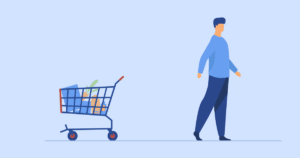
If you’re new to online marketing, you’ve likely heard the term sales funnel thrown around, but what does it actually mean? A sales funnel explained in simple terms is a structured process that guides potential customers from discovering your brand to making a purchase—and beyond. Whether you’re a business owner, coach, or digital marketer, understanding funnel basics is critical to turning strangers into loyal customers. In this beginner-friendly guide, we’ll break down how funnels work, explore the sales process, and provide actionable insights to help you master lead conversion. Let’s dive in!
What Is a Sales Funnel?
A sales funnel is a visual representation of the customer journey, mapping out each step from initial awareness to final purchase. Think of it as a funnel-shaped pathway: wide at the top, where you attract a broad audience, and narrow at the bottom, where only the most engaged prospects convert into customers. The sales funnel explained in this way highlights its purpose: to filter and nurture leads systematically, maximizing lead conversion while minimizing wasted effort.
Why Are Sales Funnels Important?
Funnels streamline the sales process by:
- Attracting the right audience: Targeting people who are likely to buy.
- Building trust: Guiding prospects through a journey that addresses their needs.
- Increasing conversions: Turning more leads into paying customers.
- Scaling revenue: Creating repeatable systems for consistent sales.
For example, a fitness coach might use a sales funnel to attract gym-goers with a free workout plan, nurture them with emails, and convert them into clients for a premium coaching program. Understanding funnel basics ensures you’re not just chasing clicks but building a system for sustainable growth.
The Stages of a Sales Funnel Explained

A sales funnel typically consists of four key stages: Awareness, Interest, Decision, and Action (often referred to as the AIDA model). Let’s break down how funnels work by exploring each stage with real-world examples.
1. Awareness (Top of the Funnel – TOFU)
At the top of the sales funnel, your goal is to attract as many relevant prospects as possible. This is where people first discover your brand through ads, social media, blog posts, or videos.
- Example: A skincare brand runs a Facebook ad offering a free “Guide to Clear Skin” to attract women aged 25–40 struggling with acne.
- Tactics: Use blog content, social media posts, or paid ads with compelling headlines like “Struggling with Breakouts? Try This One Simple Trick.”
- Key Metric: Impressions or reach (how many people see your content).
Pro Tip: Focus on solving a specific problem to attract the right audience. A vague ad like “Buy Our Products” won’t resonate as well as “Discover the Secret to Glowing Skin.”
2. Interest (Middle of the Funnel – MOFU)
Once prospects are aware of your brand, the sales funnel nurtures their interest. This stage is about building trust and providing value, often through lead magnets like eBooks, webinars, or free trials.
- Example: The skincare brand sends an email sequence with skincare tips and a case study of a customer who cleared their acne using their products.
- Tactics: Offer a high-value lead magnet (e.g., a checklist or mini-course) and follow up with educational emails or retargeting ads.
- Key Metric: Opt-in rate (percentage of visitors who provide their email).
Pro Tip: Align your lead magnet with your core offer. For instance, if you sell a high-ticket course, offer a free mini-course that previews your expertise.
3. Decision (Bottom of the Funnel – BOFU)
At this stage, prospects are considering whether to buy. Your sales funnel must present a clear, compelling offer and address objections like price or trust.
- Example: The skincare brand offers a discounted starter kit with a money-back guarantee, showcased on a sleek sales page with customer testimonials.
- Tactics: Use persuasive sales pages, limited-time offers, or bonuses to create urgency. Include social proof like reviews or case studies.
- Key Metric: Conversion rate (percentage of leads who purchase).
Pro Tip: Address objections directly. For example, include an FAQ section on your sales page answering questions like “Will this work for my skin type?”
4. Action (Post-Purchase)
The sales funnel doesn’t end at the sale. This stage focuses on turning customers into repeat buyers or brand advocates through follow-ups, upsells, or loyalty programs.
- Example: The skincare brand sends a thank-you email with a discount code for a subscription plan and invites customers to join a VIP community.
- Tactics: Offer upsells (e.g., a complementary product), send thank-you emails, or create a referral program.
- Key Metric: Customer lifetime value (CLV) or repeat purchase rate.
Pro Tip: Delight customers post-purchase with unexpected value, like a free tutorial or personalized tips, to boost retention.
How Funnels Work: The Psychology Behind Lead Conversion
A sales funnel explained through a psychological lens reveals why it’s so effective. People don’t buy on impulse—they need trust, clarity, and motivation. Here’s how funnel basics leverage human behavior:
- Trust (Reciprocity): Offering a free lead magnet creates a sense of obligation, making prospects more likely to engage.
- Curiosity (Information Gap): A compelling headline like “The One Mistake Killing Your Sales” sparks curiosity, driving clicks.
- Urgency (Scarcity): Limited-time offers or countdown timers push prospects to act before missing out.
- Social Proof: Testimonials and case studies reassure prospects they’re making the right choice.
For example, a business coach might offer a free “Revenue Growth Checklist” to build trust, then use a webinar to share a client’s success story, creating social proof and urgency for their paid program.
Common Sales Funnel Mistakes to Avoid
Even with a solid understanding of how funnels work, beginners often make mistakes that sabotage lead conversion. Here are three pitfalls and how to fix them:
1. Targeting the Wrong Audience
Casting a wide net wastes budget and attracts unqualified leads. For example, a course creator targeting “entrepreneurs” instead of “new e-commerce store owners” will struggle to convert.
Fix: Define your ideal customer avatar (ICA) with details like age, pain points, and goals. Use tools like Facebook Audience Insights to refine your targeting.
2. Weak Lead Magnets
A generic or low-value lead magnet (e.g., a “5 Tips” PDF) fails to engage prospects or align with your offer.
Fix: Create a specific, high-value lead magnet that solves a pressing problem. For example, a consultant could offer a “Client Acquisition Blueprint” instead of a generic guide.
3. Poor Follow-Up
If you don’t nurture leads after they opt in, they’ll forget you. A single email won’t cut it.
Fix: Build a 5–7 email sequence that delivers value, addresses objections, and introduces your offer. For inspiration, platforms like HighConvertingFunnels.com provide proven email templates tailored to sales funnels.
How to Build Your First Sales Funnel
Ready to create a sales funnel that converts? Follow this step-by-step guide to get started:
Step 1: Identify Your Goal
What do you want your sales funnel to achieve? Examples:
- Generate leads for a coaching program.
- Sell an online course.
- Drive e-commerce sales.
Example: A yoga instructor wants to sell a $200 online course on mindfulness.
Step 2: Define Your Audience
Create a detailed ICA. For the yoga instructor:
- Demographics: Women, aged 25–45, interested in wellness.
- Pain Points: Stress, lack of time for self-care.
- Goals: Inner peace, better mental health.
Step 3: Create a Lead Magnet
Offer something irresistible that aligns with your course. Example:
- A free “5-Minute Mindfulness Meditation” video series.
Step 4: Build a Landing Page
Use a tool like Leadpages or ClickFunnels to create a simple, mobile-optimized landing page with:
- A clear headline: “Reduce Stress in Just 5 Minutes a Day.”
- A single CTA: “Get Your Free Meditation Series.”
- Social proof: “Join 2,000+ Women Finding Calm Daily.”
Step 5: Drive Traffic
Use paid ads (e.g., Facebook or Google Ads) or organic channels (e.g., Instagram posts or blog content) to send traffic to your landing page.
Example: The yoga instructor runs a Facebook ad targeting “women interested in yoga and meditation” with the headline “Free 5-Minute Meditation to Melt Stress.”
Step 6: Nurture Leads
Set up an email sequence to build trust and introduce your offer:
- Deliver the meditation series and thank the lead.
- Share a success story of a client who found calm through your methods.
- Address objections (e.g., “No time? Our course fits busy schedules”).
- Introduce the course with a limited-time discount.
- Create urgency: “Enroll Now—Offer Ends in 48 Hours.”
Step 7: Track and Optimize
Monitor key metrics:
- Click-Through Rate (CTR): Aim for 2–3% on ads.
- Opt-In Rate: Target 20–30% for lead magnets.
- Conversion Rate: Aim for 5–10% for course sales.
Use tools like Google Analytics or ClickFunnels to track performance and A/B test elements like headlines or CTAs.
For expert guidance on building your first sales funnel, HighConvertingFunnels.com offers beginner-friendly templates and strategies to streamline the sales process.
Tools to Simplify Your Sales Funnel
You don’t need to be a tech wizard to build a sales funnel. Here are beginner-friendly tools to get started:
- ClickFunnels: All-in-one platform for landing pages, email sequences, and sales pages.
- Leadpages: Affordable tool for creating high-converting landing pages.
- Mailchimp: Free email marketing for nurturing leads.
- Canva: Design eye-catching visuals for ads and lead magnets.
Measuring Success in Your Sales Funnel
A successful sales funnel isn’t just about leads—it’s about quality leads that convert. Track these metrics:
- Cost Per Lead (CPL): Ensure it aligns with your offer’s price.
- Conversion Rate: Measure how many leads become customers.
- Return on Ad Spend (ROAS): Aim for 3x or higher.
- Customer Lifetime Value (CLV): Focus on repeat purchases to maximize revenue.
If your funnel underperforms, revisit your audience targeting, lead magnet, or email sequence. Small tweaks can lead to big results.
Conclusion

A sales funnel explained in simple terms is a roadmap for turning strangers into customers. By understanding funnel basics, mastering the sales process, and leveraging psychological triggers, you can create a system that drives consistent lead conversion. Start by defining your audience, crafting a compelling lead magnet, and building a cohesive journey from awareness to action. With tools like HighConvertingFunnels.com and a commitment to testing, your sales funnel can become a powerful engine for growth.
Take the first step today: identify your ideal customer, create a lead magnet, and start building your sales funnel. The results will speak for themselves.



